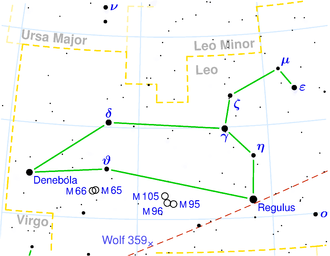NGC 3367
| Galaxy NGC 3367 |
|
|---|---|

|
|
| SDSS recording | |
| AladinLite | |
| Constellation | lion |
|
Position equinox : J2000.0 , epoch : J2000.0 |
|
| Right ascension | 10 h 46 m 34.9 s |
| declination | + 13 ° 45 ′ 03 ″ |
| Appearance | |
| Morphological type | SB (rs) c / LINER / Sy1 |
| Brightness (visual) | 11.4 mag |
| Brightness (B-band) | 12.1 mag |
| Angular expansion | 2.5 ′ × 2.4 ′ |
| Position angle | 57 ° |
| Surface brightness | 13.2 mag / arcmin² |
| Physical data | |
| Affiliation | LGG 216 |
| Redshift | 0.010142 ± 0.000024 |
| Radial velocity | 3040 ± 7 km / s |
|
Stroke distance v rad / H 0 |
(132 ± 9) · 10 6 ly (40.4 ± 2.8) Mpc |
| diameter | 100,000 ly |
| history | |
| discovery | William Herschel |
| Discovery date | March 19, 1784 |
| Catalog names | |
| NGC 3367 • UGC 5880 • PGC 32178 • CGCG 066-011 • MCG + 02-28-005 • IRAS 10439 + 1400 • 2MASX J10463496 + 1345026 • GC 2193 • H II 78 • h 748 • HIPASS J1046 + 13 | |
NGC 3367 is a bar-spiral galaxy with an active nucleus of the Hubble type SBc in the constellation Leo on the ecliptic . It is estimated to be 132 million light-years from the Milky Way and about 100,000 light-years across.
The galaxies NGC 3357 , NGC 3377 , NGC 3391 are located in the same area of the sky .
The supernovae SN 1986A ( Type-Ia ), SN 1992C (Type-II), SN 2003aa (Type-Ia) and SN 2007am (Type-II) were observed here.

Image taken with the MPG / ESO 2.2 m telescope of the La Silla Observatory on January 30, 1992; SN 1992C can be seen in the lower left corner
The object was on 19 March 1784 by William Herschel with his 18,7- inches - Mirror Telescope discovered.
NGC 3367 group ( LGG 216 )
| Galaxy | Alternative name | Distance / million Lj |
|---|---|---|
| NGC 3367 | PGC 32178 | 132 |
| NGC 3391 | PGC 32347 | 128 |
| NGC 3419 | PGC 32535 | 131 |
| PGC 32540 | NGC 3419A | 133 |
Web links
Commons : NGC 3367 - collection of images, videos, and audio files
- SIMBAD Astronomical Database
- Spectrum .de: labeled image of the surroundings
